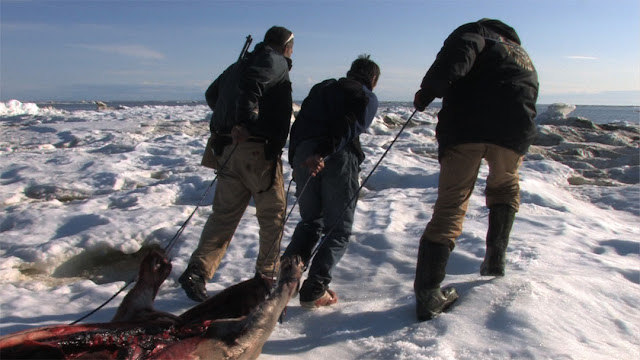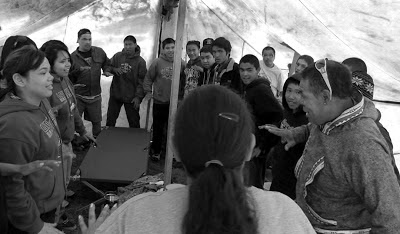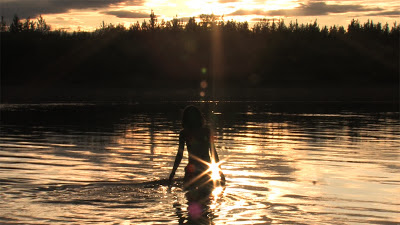Spiritual Listening: Alaska Natives Tackle Youth Suicide with Lessons from the Land
Published in Indian Country Today in 2013. For more on topics like this, see my book, American Apartheid: The Native American Struggle....
 Some years ago, Yup’ik mentor Keggulluk was setting up
a camp in northern Alaska with the help of an at-risk teen he’d taken under his
wing. The youngster had been abusing alcohol and gas huffing—inhaling gasoline
fumes, which induces hallucinations and causes brain damage and even death. The teen was on track to become one of the many
Alaska Natives who kill themselves each year, at a rate at least three times
the national average—in some areas, far higher than that.
Some years ago, Yup’ik mentor Keggulluk was setting up
a camp in northern Alaska with the help of an at-risk teen he’d taken under his
wing. The youngster had been abusing alcohol and gas huffing—inhaling gasoline
fumes, which induces hallucinations and causes brain damage and even death. The teen was on track to become one of the many
Alaska Natives who kill themselves each year, at a rate at least three times
the national average—in some areas, far higher than that.“The problem has exploded so recently and appears to be still growing, with no end in sight,” said Keggulluk, who is also known as Earl Polk. “It’s a grueling, non-stop battle to save our youth.”
As a result of all the suicide-risk factors bearing
down on their children, area tribes had put together a suicide-prevention camp.
For several days, the kids would live in the wilderness and benefit from its
lessons.
It was a cool, clear September morning when the teen
and Keggulluk (pronounced kuth-look)
began to put up tents and haul wood and water to prepare for the arrival of the
15 other campers. Suddenly, an enraged bull moose appeared and charged
Keggulluk. The youngster took aim with a hunting rifle. “Don’t miss!”
Keggulluk exhorted.
The teen fired and brought down the moose. Not only
did he rescue Keggulluk, but the shock of simultaneously killing his first moose,
provisioning his community in the manner of his ancestors and saving a man’s
life put the young man on the road to recovery from his addictions. “It
was a spiritual moment, an honorable moment,” explains Keggulluk. “As the young
man took care of the dying animal in our way, pouring water from his own mouth
into the moose’s, the animal breathed his last breath, and the young man felt it
go through him. It was a blessing.”
Later, the youngster challenged Keggullukk: “I
thought you were going to lecture me on gas huffing.”
“I will,” Keggulluk recalled telling the teen, “but first
we had to take care of some other things.”
That young man was lucky. Others aren’t. For Alaska
Native males aged 15 to 24, the suicide rate is 12 times that for
other Americans, making it the highest of any population group in the nation,
according to the state’s Bureau of Vital Statistics.
In recent years, Keggulluk and Maniilaq Association
wellness coordinator Evon Peter, Gwich’in, have offered suicide-prevention
camps through Maniilaq, which represents tribes north of the Bering Strait, and
Kawerak Association, with represents tribes grouped around the Strait. The
events offer four to five days of songs, dances, traditional games and storytelling,
outdoor activities like hunting and fishing, and lots of laughter. “These
interactions are about being ourselves in unguarded moments, not as we’ve been
told to be by outsiders,” said Peter.
Often, what’s taught isn’t obvious. “The real lesson is often not what we adults say, but rather how we are—how we interact, solve problems, and so
on,” said Peter.
 In addition to running the camps, which are supported
by the Indian Health Service’s Methamphetamine and Suicide Prevention
Initiative, Peter and Keggulluk collaborate on school programs for the early
grades through high sc
In addition to running the camps, which are supported
by the Indian Health Service’s Methamphetamine and Suicide Prevention
Initiative, Peter and Keggulluk collaborate on school programs for the early
grades through high sc
The youngsters referred to the Maniilaq and Kawerak
camps may have abused alcohol or drugs, experienced domestic violence or
neglect, been a bullying perpetrator or victim, or suffer from fetal alcohol
effects, according to Peter. “We aren’t told why a youth is referred to us,
though it often comes out in the safe space the camp affords. The children feel
honored and protected, they build peer networks, and they come to see the adults
as mentors.” After three or four days, he said, even the tough ones open up.
The camps can do only so much to abate the high
Alaska Native suicide rate, though, Peter cautioned. A youngster may return to
a difficult home situation, and the risk rises again.
Understanding
suicide
Suicide is what scholar Lisa Wexler called “an unruly
phenomenon.” An individual decision impacted by many factors, it’s more
difficult to predict and prevent than other public-health issues, said Wexler.
A professor at the University of Massachusetts Center for Research on Families,
she has worked with communities in Alaska since 2000, focusing on suicide and
suicide prevention.
“My research is not about, but with, the people. It’s
intended to start a conversation and bring awareness,” said Wexler. For the
last three years, she and Peter have worked together to offer communities
suicide-awareness training tailored to their needs.
One obstacle to understanding Native suicide in
Alaska is the large variation among communities, said Peter. “Although Alaska
Native people have high suicide rates overall, several large tribal groups in
the state have rates lower than the U.S. average. We also have villages with
very high numbers—an annual average of 12 individuals out of a few hundred
taking their own lives, for example—next to villages with one suicide in
decades.” That means there are no cookie-cutter solutions, he said. “When we go
to a village, we ask how we can help.”
More research will help explain the differences among
villages, Peter said. Recent studies in the United States and Canada show that
indigenous communities with strong traditions and active involvement in
sovereignty issues experience less suicide. Wexler is also looking into
historical events that may lie behind Alaska’s suicide clusters. “An epidemic
may have wiped out one village’s elders at some point,” she postulated. “In
another village, an abusive priest may have devastated many children.”
Some things are known, thanks to Maniilaq’s many
years of suicide data and Wexler’s existing studies. In an analysis of hospital
visits, she found that 40 percent of males who killed themselves had been
treated for an alcohol-related injury in the year prior to the suicide. “Forty
percent is statistically very significant,” said Wexler. “So, we were able to
share with the communities that if anyone shows up for such treatment,
health-care workers can talk to them about suicide.”
The data also shows that Alaska Native suicide occurs
primarily among 15-24–year-olds. It’s also a recent phenomenon—unknown until
the 1960s, said Wexler. By that time, mandatory-schooling regulations had
forced the region’s traditionally nomadic people into sedentary villages.
That altered lifeways and social structure, Wexler
said. “For the first time, a sizeable number of young people were living
together and were no longer an integral part of their family’s survival.
Simultaneously, media and external influences grew.” Unemployment and lots of
empty time for many people exacerbated the difficulties of adjusting to the new
life.
Men and
boys
 Boys and young men have typically had a harder time
coping with the modern Arctic than girls and young women, Wexler said. “Girls
and women have generally been able to integrate traditional and contemporary
roles. They know they’re valued for caring for siblings and elders and for
having children of their own, as well as for doing well in school.” Boys, on
the other hand, often can’t afford to hunt, the activity that still defines
manhood in the region. “It takes cash to hunt, for the snowmobile or boat, and
for the gasoline to run them,” said Wexler.
Boys and young men have typically had a harder time
coping with the modern Arctic than girls and young women, Wexler said. “Girls
and women have generally been able to integrate traditional and contemporary
roles. They know they’re valued for caring for siblings and elders and for
having children of their own, as well as for doing well in school.” Boys, on
the other hand, often can’t afford to hunt, the activity that still defines
manhood in the region. “It takes cash to hunt, for the snowmobile or boat, and
for the gasoline to run them,” said Wexler.
For many men, their activities as providers have
shifted dramatically, confirmed Keggulluk, a virtuosic hunter in the
traditional manner. They have to hold down jobs, rather than hunt caribou,
moose and seals. “This is not about to come back.”
That, in turn, means one of the critical lessons of
the Arctic is hard to come by. Keggulluk recalled that his grandfather once
told him, “Those who don’t listen die young.” In the unforgiving North of old,
a hunter stayed alive from moment to moment by listening to elders, fellow
hunters, the natural world and his own instincts. He was exquisitely sensitive
to subtle clues that made the difference between a successful hunt and losing
his life under the ice or in an avalanche, between sustenance and death.
“In addition to the practical component, there’s a
metaphysical one—spiritual listening,” Keggulluk said. “This is a huge part of
what’s missing today for our young people.”
 Today’s world distracts youngsters from the land’s
messages and from who they are, he explained. “The onslaught of outside
information fights with what’s running in their veins. The contrast between
life on the tundra and elsewhere is staggering. When our young people go away
to school, they find new models for success and learn things that are not
relevant at home. This can cause raging conflict.”
Today’s world distracts youngsters from the land’s
messages and from who they are, he explained. “The onslaught of outside
information fights with what’s running in their veins. The contrast between
life on the tundra and elsewhere is staggering. When our young people go away
to school, they find new models for success and learn things that are not
relevant at home. This can cause raging conflict.”
That, according to Keggulluk, is where the
suicide-prevention camps and their deep listening come in. It may be the first
time in some participants’ lives that they can talk to an adult who listens
compassionately and nonjudgmentally, Peter said. “We teachers can find
ourselves sitting on the beach for hours, listening to a kid talk about intense
things. Then the healing can begin.”
Breathing
Lessons
In We Breathe
Again, a movie in production about Alaska Native suicide-prevention work, a
man talks about his suicide attempt. “I wanted to hunt. I wanted to put food
aside, but I couldn’t do it without a vehicle and gas money.” He began drinking
and finally turned a gun on himself. The last thing he remembers saying to his
family before the gun went off was, “By god, I love you all.”
The people in the film were courageous, willing to
talk about moments of anguish as well as triumph, so that others can learn from
their experiences, said director and cinematographer Marsh Chamberlain, shown here with executive producer Evon Peter and featured interviewee Keggulluk.
“Listening to them has been such a privilege. We Breathe Again is about serious issues, but it’s also uplifting—a
healing journey. Whatever our characters have been through, they’re all living
healthy lives now, so that hasn’t been hard to do.”
Native American Public Television is funding the
movie, now in the editing phase. A trailer can be seen on Vimeo
(vimeo.com/46032413). According to Evon Peter, who is Gwich’in, the
film shows both what drives a person to suicide and the healing work Alaska
Native people are doing.
New Hampshire-raised Chamberlain first got to know
the Arctic in 2006, after an aunt married into the Inupiat tribe.
“Conversations with an Inupiat cousin changed my life,” Chamberlain recalled. “Nathan Nagaruk shared his joys and despairs. As we dug deeper, he told me of friends lost to suicide
and the effect on individuals and communities. I had no idea this was such an
issue for Native people.”
The two young men decided to make a difference and
began creating a movie in 2007, with Nagaruk a producer. In 2010, Peter came on board to consult and offer links to more communities.
Alaska’s glorious terrain, with its wintery mountains
and glaciers and vast grassy plains in summer, surrounds the five primary
interviewees as they affirm the vital connections to land, culture and
community that mean surviving—and thriving—in the new Arctic. They hunt, they
pick berries, they sing and share and laugh.
Final versions will include a 1½-hour theatrical
release, to be screened in January 2014, a 56-minute public-television version
ready for broadcast in May 2014 and an even shorter version for school
showings. “We’ll submit We Breathe Again
to Sundance, Tribeca and other major film festivals,” said Peter. “And we’re
looking for a grant to make DVDs, so we can distribute them to schools and
communities.”
Said Keggulluk, who is Yup’ik: “I told Marsh he had to document our austere way of
life, and to do so in real time. I get calls all the time. A week ago, there
was yet another suicide, and yesterday I lost a nephew. It’s so hard, so intense,
like a powerful undercurrent that can draw a person under at any moment.”
Keggulluk compared the ongoing transformations—real
and filmic—to ever-changing Arctic snowdrifts: “As lives shift, the movie
shifts.”
Text c. Stephanie Woodard; photographs c. Marsh Chamberlain, used with permission.


